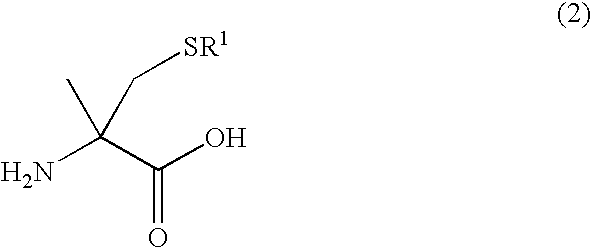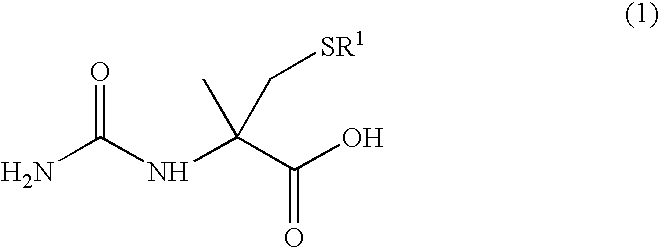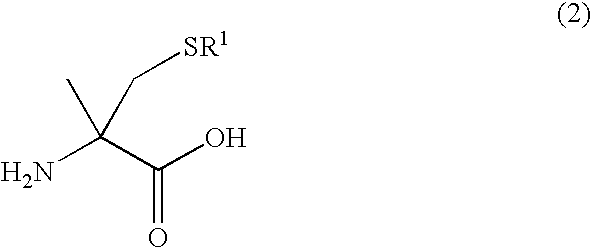Process for producing optically active alpha -methylcysteine derivative
a technology of methylcysteine and alpha methylcysteine, which is applied in the direction of hydrolases, fermentation, etc., can solve the problems of difficult mass production of ple, many complex steps of process (5), and high cost of reagents, and achieve the effect of being readily availabl
- Summary
- Abstract
- Description
- Claims
- Application Information
AI Technical Summary
Benefits of technology
Problems solved by technology
Method used
Image
Examples
reference example 1
Process for producing racemic 5-methyl-5-tert-butylthiomethylhydantoin
[0046] In a reactor with a nitrogen balloon, a 5 wt % aqueous solution of sodium hydroxide (9.6 g) and tert-butylmercaptan (1.13 mL) were mixed at 0° C., and the mixture was stirred for 10 minutes. Subsequently, chloroacetone (0.79 mL) was added. The temperature was increased to room temperature and the reaction was performed for 2 hours. This reaction mixture was pale yellow and was separated to two phases. A Dimroth condenser was provided to the reactor and sodium cyanide (588 mg), ammonium hydrogencarbonate (2.77 g), and 30 wt % aqueous ammonia (3.1 mL) were added to provide a homogeneous solution. Subsequently, the temperature was increased to 55° C. to 60° C. The reaction mixture was heated and stirred for 6 hour and was then cooled to 0° C. Concentrated hydrochloric acid was added to the reaction mixture so that the pH was adjusted to 7.0 to 7.6. The resultant white crystals (1.84 g) were filtered (yield 84...
reference example 2
Process for producing racemic N-carbamyl-S-tert-butyl-α-methylcysteine
[0047] Racemic 5-methyl-5-thiomethylhydantoin (4.77 g) was dissolved in a 10 wt % aqueous solution of sodium hydroxide (75 g) and the mixture was refluxed for 72 hours. The reaction mixture was left to cool to room temperature and a part of the reaction mixture was then sampled. The formation of racemic S-tert-butyl-α-methylcysteine was confirmed by an analysis using high performance liquid chromatography (HPLC) The pH was adjusted to 8 with concentrated hydrochloric acid and the mixture was then heated to 70° C. A solution dissolved potassium cyanate (2.07 g) in distilled water (10 mL) was added dropwise over a period of 20 minutes. After the dropwise addition, the reaction mixture was stirred for 5 hours. Subsequently, a part of the reaction mixture was sampled and analyzed by HPLC. Since an unreacted amino acid was detected, a solution dissolved potassium cyanate (4.14 g) in distilled water (20 mL) was further...
example 1
Production of S-tert-butyl-α-methyl-L-cysteine using bacteria of genus Agrobacterium
[0049]Agrobacterium sp. KNK712 (FERM BP-1900) was inoculated in a culture medium A (10 mL) (polypeptone 10 g, a meat extract 10 g, yeast extract 5 g, glycerin 5 g, potassium dihydrogenphosphate 5 g, disodium hydrogenphosphate 5 g, and water 1 L, pH 6.5 before sterilization) that was sterilized in a test tube, and the solution was incubated with shaking at 30° C. for 24 hours. The culture broth (1 mL) was inoculated in a culture medium B (100 mL) (glycerin 25 g, sucrose 5 g, yeast extract 4 g, potassium dihydrogenphosphate 5 g, disodium hydrogenphosphate 5 g, magnesium phosphate heptahydrate 1 g, manganese chloride tetrahydrate 0.01 g, and water 1 L, pH 6.5 before sterilization) that was sterilized in a Sakaguchi flask. Urea (0.2 g) and N-carbamyl-D-p-hydroxyphenylglycine (0.2 g) that were sterilized by filtration were further added to the solution. The solution was incubated with shaking at 33° C. f...
PUM
| Property | Measurement | Unit |
|---|---|---|
| temperature | aaaaa | aaaaa |
| temperature | aaaaa | aaaaa |
| temperature | aaaaa | aaaaa |
Abstract
Description
Claims
Application Information
 Login to View More
Login to View More - R&D
- Intellectual Property
- Life Sciences
- Materials
- Tech Scout
- Unparalleled Data Quality
- Higher Quality Content
- 60% Fewer Hallucinations
Browse by: Latest US Patents, China's latest patents, Technical Efficacy Thesaurus, Application Domain, Technology Topic, Popular Technical Reports.
© 2025 PatSnap. All rights reserved.Legal|Privacy policy|Modern Slavery Act Transparency Statement|Sitemap|About US| Contact US: help@patsnap.com



